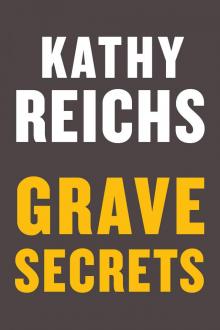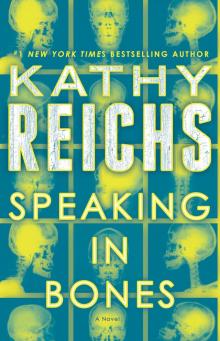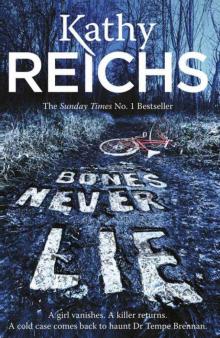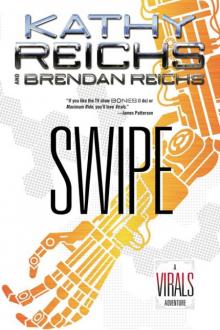- Home
- Kathy Reichs
Cross Bones Page 11
Cross Bones Read online
Page 11
I moved on to stature.
Selecting the leg bones, I eliminated those with eroded or damaged ends, and measured the rest on an osteometric board. Then I plugged the measurements into Fordisc 2.0, and asked for a calculation using all males in the database, with race unknown.
Height: sixty-four to sixty-eight inches.
I spent the next several hours scrutinizing every knob and crest and hole and notch, every facet and joint, every millimeter of cortical surface under magnification. I found nothing. No genetic variations. No lesions or indicators of illness. No trauma, healed or otherwise.
No penetrating wounds in the hands or feet.
Killing the fiber-optic light on the scope, I arched backward and stretched, my shoulders and neck feeling like someone had set them on fire.
Could it be I was getting older?
No way.
I crossed to my desk, dropped into my chair, and checked my watch. Five fifty-five. Midnight in Paris.
Too late to phone.
Jake answered sounding groggy and asked me to wait.
“What’s up?” Jake had returned, whooshing a pop-top.
“It ain’t Jesus.”
“What?”
“The skeleton from the Musée de l’Homme.”
“What about it?”
“I’m looking at it.”
“What?”
“It’s a middle-aged white guy of average stature.”
“What?”
“You’re not holding up your end of this conversation, Jake.”
“You have Lerner’s bones?”
“The skeleton he liberated is here in my lab.”
“Christ!”
“Not this guy.”
“You’re sure?”
“This guy saw forty come and go. My best estimate says he was at least fifty at death.”
“Not eighty.”
“No way.”
“Could he have been seventy?”
“I doubt it.”
“So it’s not the older Masada male referred to by Yadin and Tsafrir.”
“Do we know for a fact that Yadin’s old guy was the isolated skeleton?”
“Actually, no. The older bones could have been mixed in with the main heap. That would leave the isolated skeleton as one of the fourteen males aged twenty-two to sixty.”
“Or totally unaccounted for.”
“Yes.” There was a long pause. “Tell me how you got the skeleton.”
I told him about Morissonneau and my visit to the monastery.
“Holy shit.”
“That’s what Ryan said.”
When Jake spoke again his voice was almost a whisper.
“What are you going to do?”
“First off, tell my boss. These are human remains. They were found in Quebec. They’re the coroner’s responsibility. Also, the bones may be evidence in a homicide investigation.”
“Ferris?”
“Yes.”
“And then?”
“Undoubtedly my boss will tell me to contact the appropriate authorities in Israel.”
There was another pause. Sleet plopped against the window above my desk and ran in rivulets down the glass. Twelve floors below, traffic clogged the streets and crawled the Jacques Cartier Bridge. Taillights drew glistening red ribbons on the pavement.
“You’re sure this is the skeleton in the Kessler photo?”
Good question. One I hadn’t considered.
“I saw nothing to rule that out,” I said.
“Anything to rule it in?”
“No.” Lame.
“Is it worth another look?”
“I’ll do it now.”
“Will you talk to me before you contact Israel?”
“Why?”
“Please promise you’ll ring me first?”
Why not. Jake had initiated this whole thing.
“Sure, Jake.”
When we hung up, I sat a moment, hand resting on the receiver. Jake sounded uneasy about my notifying the Israeli authorities. Why?
He wanted first claim on rights to publish concerning the discovery and analysis of the skeleton? He feared losing control of the skeleton? He distrusted his Israeli colleagues? He distrusted the Israeli authorities?
I had no idea. Why hadn’t I asked?
I was hungry. My back hurt. I wanted to go home, have dinner with Birdie and Charlie, and curl up with my book.
Instead I dug out Kessler’s photo and placed it under the scope. Slowly, I moved from the top of the skull south over the face.
The forehead showed no unique identifier.
Eyes. Nothing.
Nose. Nothing.
Cheekbones. Nothing.
I twisted my head right, then left to relieve the pain in my neck.
Back to the scope.
When the mouth came into view, I stared through the eyepiece. I looked up and across my worktable at the skull.
Something wasn’t right.
Returning my eyes to the scope, I increased magnification. The teeth ballooned.
I brought the central incisor into focus, then inched from the midline toward the back of the jaw.
My stomach knotted.
I got up, retrieved my magnifying glass, and picked up the skull. Rotating the palate upward, I examined the dentition.
The knot tightened.
I closed my eyes.
What the hell could this mean?
13
I CARRIED THE PHOTO FROM THE SCOPE TO THE skull. Using the hand lens, I counted from the midline of the palate to a gap on the right.
Two incisors, one canine, two premolars. Gap. Two molars.
The skeleton in Kessler’s print was missing its first upper molar on the right.
The skull on my worktable was not.
Was this not the skeleton pictured in the photo?
I returned to the scope, raised it, and positioned the skull. Then I directed the fiber-optic light onto the right maxillary molars.
Under magnification, I could see that the molar roots were exposed more than normal. The socket edges were pitted and porous.
Periodontal disease. No big deal.
What was a big deal was the condition of the right first upper molar’s chewing surface. The cusps were high and rounded, while the cusps on the adjacent molars were completely ground down.
What the hell was that all about?
I articulated the jaw and noted occlusion. The first molar made contact before any other molar in the row. If anything, the first molar should have exhibited greater wear than its neighbors, not less.
I leaned back and considered.
There were two possibilities. A. This was a different skeleton from that in the Kessler photo. B. This was the same skeleton, but with a molar inserted into the gap.
If a molar had been inserted, there were two possibilities. A. It was the actual tooth that had been lost from the jaw. Teeth often fall out once the soft tissue decomposes. B. It was the tooth of another, mistakenly inserted into the jaw. This possibility would explain the differential cusp wear.
When had the tooth been reinserted? Three possibilities seemed reasonable. A. At the time of burial. B. During Yadin’s excavation. C. During the skeleton’s stay at the Musée de l’Homme.
My instincts said B.
Okay. If the tooth was replaced during the Masada dig, who had done it? Many possibilities. A. Yadin. B. Tsafrir. C. Haas. D. An excavator.
My gut feeling?
An excavator found the tooth beside the skeleton, tried the jaw, it seemed to fit, he stuck it in. The Cave 2001 bones were jumbled. Good records weren’t kept. Mistakes happen all the time with students and unskilled volunteers.
So. Funerary act? Simple error? Neither of the above, different skeleton than that in Kessler’s photo?
I was in over my head. I needed an odontologist.
It was now ten past seven on a Saturday night. I knew what Marc Bergeron, our lab’s dental expert, would say.
Get apical X-rays.
I couldn’t do that until Monday.
Frustrated, I spent the next hour studying Kessler’s print under magnification.
I spotted no anatomical quirk or detail that could tie the skeleton in the photo unequivocally to the bones on my table.
* * *
For the rest of the evening I sat around feeling agitated and blocked. Birdie and I watched an NCAA basketball game. I was strongly for Duke. Bird was pulling for the Clemson Tigers. Probably a feline thing.
Sunday morning it took less than thirty minutes online to locate and order the Donovan Joyce book. The Jesus Scroll. Ads blurbed it as the most disturbing work ever written about Christianity. Good press. Too bad the thing was out of print.
Every few hours I called Jake. His mobile was off. At one, I quit leaving messages and tried his hotel. He’d checked out.
Ryan’s surveillance ended with three arrests and the confiscation of a truckload of cigarettes. He showed up at six, eyes deeply shadowed, hair wet from the shower. I had a Perrier, Ryan had a Moosehead, then we walked to Katsura on rue de la Montagne.
My patch of centre-ville was quiet. Few students milled outside Concordia University. Few fun-seekers partied on rue Crescent.
There’s something ’bout a Sunday.
Or maybe it was the temperature. Overnight, Saturday’s sleet had given way to clear skies and arctic cold.
Over sushi, I gave Ryan the rundown on Morissonneau’s skeleton, ending with my conclusion that the bones were those of a white male aged forty to sixty at the time of his death.
“So my age estimate rules out the Cave 2001 septuagenarian, the Bible’s thirty-three-year-old Jesus, and Donovan Joyce’s eighty-year-old Jesus.”
“But you’re certain Kessler’s photo shows the isolated skeleton in Cave 2001, and that that skeleton is the one Lerner stole from the Musée de l’Homme and gave to Ferris, who gave it to Morissonneau?”
“Jake’s certain. He’s talked to someone who worked as a volunteer excavator in Cave 2001. But I can’t find a single unique identifier to unequivocally tie Morissonneau’s skeleton to the one in Kessler’s photo. And there’s something going on with one of the teeth.”
I told Ryan about the odd molar.
“So you suspect it’s not the same skeleton?”
“Or it is the same skeleton, but the molar was inserted after the photo was taken.”
“Someone found the guy’s missing tooth during recovery and stuck it back in the socket?”
“Possibly.”
“You sound unconvinced.”
“The cusps look less ground down to me.”
“Meaning the tooth could be from another person, someone younger.”
“Yes.”
“Meaning?”
“I don’t know. Maybe just a mix-up. Yadin used volunteers. Maybe one of them inserted the molar, thinking it belonged.”
“You’re going to see Bergeron?”
“Monday.”
Ryan filled me in on his lead in the Ferris case.
“When I ran the name Kessler, not a lot popped out.”
“Dearth of Jewish felons?”
“Meyer Lansky,” Ryan said.
“I stand corrected,” I said.
“Bugsy Siegel,” Ryan added.
“Twice.”
“David Berkowitz.”
“Thrice.”
“Elegant,” Ryan said.
“Shakespearean,” I agreed.
“When I tinkered around, what did pop out was a guy named Hershel Kaplan.”
I was stumped. What follows thrice. Frice? Quatrice?
“Kaplan’s a small-time hustler. Did a couple of bumps for white-collar stuff. Credit card fraud. Check forgery. Also goes by the names Hershel Cantor and Harry Kester.”
“Let me guess. Kessler was also one of Kaplan’s aliases.”
“Hirsch Kessler.” Ryan dug a photocopy from his back pocket. “That your boy?”
I studied the photo. Glasses. Dark hair. This guy was clean-shaven.
“Maybe.” They all look alike? I felt like a moron.
I closed my eyes and conjured Kessler.
I opened my eyes and stared at the mug shot.
Subconscious ring-a-ding. What?
The craning neck. The drooping lids. A word when Kessler ambushed me outside the family room. Turtle. I’d forgotten. The same word had again flashed into my mind.
“Kessler had a beard. But I think it’s the same man.” I handed the paper back. “Sorry. It’s the best I can do.”
“It’s a start.”
“Where’s Kessler now? Kaplan?”
“I’m looking into that.”
Back home, Ryan talked with Charlie while I showered. I was standing naked by my dresser when he entered the bedroom.
“Freeze.”
I turned, a lace baby doll nightie in one hand, a satin charmeuse slip in the other.
“I’m going to have to know what you’re doing, ma’am.”
“You a cop?”
“That’s why I ask the tough questions.”
I raised the lingerie and a questioning brow.
“Put down the nighties and step away from the dresser.”
I did.
* * *
It was a typical Monday morning madhouse at the lab. Four dead in a house fire. One shooting. One hanging. Two stabbings. A crib death.
Only one case for me.
Objects had been found in the basement sink of an apartment high-rise in Côte Saint-Luc. Police suspected they were the skull bones of an infant or toddler.
After the morning meeting, I asked LaManche to follow me to my lab. I showed him Morissonneau’s skeleton, filled him in on its history and possible provenance, and explained how it had come into my possession.
As expected, LaManche assigned the remains an LSJML number, and told me to treat them as a coroner case. Final resolution would be my call. Should I declare the bones ancient, I was free to release them to the appropriate archaeologists.
When LaManche had gone, I asked my lab technician, Denis, to X-ray the skeleton’s dentition. Then I got down to the baby.
I had to admit the specimens looked like two very young and incomplete parietal bones. The concave surfaces showed the vascular patterning produced by close association with the brain’s outer surface.
Cleaning resolved the issue.
The “bones” were fragments of coconut shell. The venous patterning was the result of water action on caked mud.
When I’d delivered my report to the secretary’s office, Denis handed me a small brown envelope. I dumped the contents onto my light box.
One look strengthened my suspicion that the first maxillary molar had been reinserted into the skeleton’s jaw. And not too skillfully. On X-ray, I could see that the tooth’s angle was slightly wrong, and that the roots didn’t conform properly to their sockets.
And something else.
As a tooth ages, its cusps grind down. Okay. I’d spotted the discrepancy in wear. But other features also change with time. The older a tooth, the more secondary dentin in its pulp chamber and canal.
I’m no dentist, but the right first maxillary molar looked less radio-opaque than the other molars.
I phoned Marc Bergeron. His receptionist put me on hold. I listened to a Thousand Strings play something resembling “Sweet Caroline.” In my mind’s eye I saw a patient, reclined, agape, tubing sucking at his mouth. I was glad it wasn’t me.
Marc picked up during a mind-numbing version of “Uptown Girl.” He’d squeeze me in that afternoon.
Jake called as I was packaging the skull.
“Did you get my messages?” I asked.
“I checked out Saturday and took the midnight flight to Tel Aviv.”
“You’re in Israel?”
“Jerusalem. What’s up?”
I told him about the inconsistency between the skeleton in the photo and the skeleton in my lab, and described the seemingly ab
errant molar.
“What does it mean?”
“I’m seeing our odontologist this afternoon.”
There was a long, long pause. Then, “I want you to pull that molar and one or two others.”
“Why?”
“For DNA testing. I also want you to cut femoral segments. Is that a problem?”
“If Ferris and Lerner are right, these bones are almost two thousand years old.”
“It’s possible to extract mitochondrial DNA from old bone, right?”
“It’s possible. But then what? Forensic analysis is based on comparison, either to the victim’s own DNA, or to that of a family member. If mtDNA could be extracted and amplified, to what would you compare it?”
Long Jake pause. Then, “New finds are unearthed every day. You never know what will turn up, or what will be relevant down the road. And I’ve got grant money specifically earmarked for this type of thing. What about race?”
“What about it?”
“Wasn’t there a recent case where profilers said the perp was white and some lab predicted, correctly, that the guy was black?”
“You’re thinking of the Derrick Todd Lee case in Baton Rouge. That test relies on nuclear DNA.”
“Can’t nuclear DNA be extracted from ancient bone?”
“Some claim to have done it. There’s a growing field of study on aDNA.”
“aDNA?”
“Ancient DNA. Folks at Cambridge and Oxford are working on getting nuclear DNA from archaeological material. Here in Canada, there’s an institute called the Paleo-DNA Laboratory in Thunder Bay.”
I remembered a recent article in The American Journal of Human Genetics.
“A French group reported on nuclear and mitochondrial DNA from skeletons dug from a two-thousand-year-old necropolis in Mongolia. But Jake, even if you could get nuclear DNA, racial prediction is very limited.”
“How limited?”
“There’s a Florida company that offers a test that translates genetic markers into a prediction of likely racial mix. They claim they can predict the percentage present of Indo-European, Native American, East Asian, and sub-Saharan-African ancestry.”
“That’s it?”
“For now.”
“Not much help with the bones of an ancient Palestinian.”
“No,” I agreed.
I listened to another of Jake’s pauses.
“But either mito or nuclear DNA analysis might show whether that odd molar belonged to a different individual.”

 Two Nights
Two Nights The Bone Collection: Four Novellas
The Bone Collection: Four Novellas Fatal Voyage
Fatal Voyage 206 Bones
206 Bones Bones to Ashes
Bones to Ashes Terminal
Terminal Monday Mourning
Monday Mourning Flash and Bones
Flash and Bones Cross Bones
Cross Bones Devil Bones
Devil Bones Break No Bones
Break No Bones Swamp Bones
Swamp Bones Déjà Dead
Déjà Dead Shock
Shock Spider Bones
Spider Bones Death Du Jour
Death Du Jour Grave Secrets
Grave Secrets Trace Evidence: A Virals Short Story Collection
Trace Evidence: A Virals Short Story Collection Bones on Ice
Bones on Ice The Bone Code
The Bone Code Bones in Her Pocket
Bones in Her Pocket Seizure:
Seizure: Speaking in Bones
Speaking in Bones Deadly Decisions
Deadly Decisions Spike
Spike Bones Never Lie
Bones Never Lie Bones of the Lost
Bones of the Lost Virals 03.5 - Swipe
Virals 03.5 - Swipe Exposure
Exposure A Conspiracy of Bones
A Conspiracy of Bones Shift (tory brennan)
Shift (tory brennan) Bones of the Lost: A Temperance Brennan Novel tb-16
Bones of the Lost: A Temperance Brennan Novel tb-16 Virals tb-1
Virals tb-1 Bones Are Forever tb-15
Bones Are Forever tb-15 Code tb-3
Code tb-3 Seizure tb-2
Seizure tb-2 Deadly Descisions
Deadly Descisions Spider Bones: A Novel
Spider Bones: A Novel